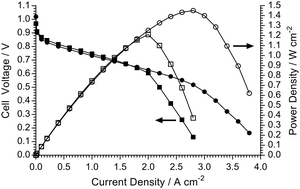当前位置:
X-MOL 学术
›
Energy Environ. Sci.
›
论文详情
Our official English website, www.x-mol.net, welcomes your feedback! (Note: you will need to create a separate account there.)
Non-fluorinated pre-irradiation-grafted (peroxidated) LDPE-based anion-exchange membranes with high performance and stability
Energy & Environmental Science ( IF 32.5 ) Pub Date : 2017-08-24 00:00:00 , DOI: 10.1039/c7ee02053h Lianqin Wang 1, 2, 3, 4 , Jethro J. Brink 1, 2, 3, 4 , Ye Liu 5, 6, 7, 8 , Andrew M. Herring 5, 6, 7, 8 , Julia Ponce-González 1, 2, 3, 4 , Daniel K. Whelligan 1, 2, 3, 4 , John R. Varcoe 1, 2, 3, 4
Energy & Environmental Science ( IF 32.5 ) Pub Date : 2017-08-24 00:00:00 , DOI: 10.1039/c7ee02053h Lianqin Wang 1, 2, 3, 4 , Jethro J. Brink 1, 2, 3, 4 , Ye Liu 5, 6, 7, 8 , Andrew M. Herring 5, 6, 7, 8 , Julia Ponce-González 1, 2, 3, 4 , Daniel K. Whelligan 1, 2, 3, 4 , John R. Varcoe 1, 2, 3, 4
Affiliation

|
Radiation-grafted anion-exchange membrane (RG-AEM) research has predominantly focused on the chemical stability of the polymer-bound positively-charged head-groups that enable anion conduction. The effect of the backbone polymer chemistry, of the precursor film, on RG-AEM stability has been studied to a lesser extent and not for RG-AEMs made from pre-irradiation grafting of polymer films in air (peroxidation). The mechanical strength of polymer films is generally weakened by exposure to high radiation doses (e.g. from a high-energy e−-beam) and this is mediated by chemical degradation of the main chains: fluorinated films mechanically weaken at lower absorbed doses compared to non-fluorinated films. This study systematically compares the performance difference between RG-AEMs synthesised from a non-fluorinated polymer film (low-density polyethylene – LDPE) and a partially-fluorinated polymer film (poly(ethylene-co-tetrafluoroethylene) – ETFE) using the peroxidation method (pre-irradiation in air using an e−-beam). Both the LDPE and ETFE precursor films used were 25 μm in thickness, which led to RG-AEMs of hydrated thicknesses in the range 52–60 μm. The RG-AEMs (designated LDPE-AEM and ETFE-AEM, respectively) all contained identical covalently-bound benzyltrimethylammonium (BTMA) cationic head-groups. An LDPE-AEM achieved a OH− anion conductivity of 145 mS cm−1 at 80 °C in a 95% relative humidity environment and a Cl− anion conductivity of 76 mS cm−1 at 80 °C when fully hydrated. Alkali stability testing showed that the LDPE-AEM mechanically weakened to a much lower extent when treated in aqueous alkaline solution compared to the ETFE-AEM. This LDPE-AEM outperformed the ETFE-AEM in H2/O2 anion-exchange membrane fuel cell (AEMFC) tests due to high anion conductivity and enhanced in situ water transport (due to the lower density of the LDPE precursor): a maximum power density of 1.45 W cm−2 at 80 °C was achieved with an LDPE-AEM alongside a Pt-based anode and cathode (cf. 1.21 mW cm−2 for the benchmark ETFE-AEM). The development of more mechanically robust RG-AEMs has, for the first time, led to the ability to routinely test them in fuel cells at 80 °C (cf. 60 °C was the prior maximum temperature that could be routinely used with ETFE-based RG-AEMs). This development facilitates the application of non-Pt catalysts: 931 mW cm−2 was obtained with the use of a Ag/C cathode at 80 °C and a Ag loading of 0.8 mg cm−2 (only 711 mW cm−2 was obtained at 60 °C). This first report on the synthesis of large batch size LDPE-based RG-AEMs, using the commercially amenable peroxidation-type radiation-grafting process, concludes that the resulting LDPE-AEMs are superior to ETFE-AEMs (for the intended applications).
中文翻译:

具有高性能和稳定性的非氟化预辐照接枝(过氧化)LDPE基阴离子交换膜
辐射接枝阴离子交换膜(RG-AEM)的研究主要集中在聚合物结合的带正电的头基的化学稳定性上,该头基可实现阴离子传导。在较小程度上研究了前体薄膜的主链聚合物化学性质对RG-AEM稳定性的影响,而不是对在空气中预辐照接枝聚合物薄膜(过氧化)制成的RG-AEM进行了研究。聚合物膜的机械强度通常是通过暴露于高辐射剂量(减弱例如从高能量E --梁),这是由主链的化学降解所介导的:与非氟化膜相比,氟化膜在较低的吸收剂量下会机械减弱。这项研究系统地比较了使用过氧化方法由非氟化聚合物薄膜(低密度聚乙烯– LDPE)和部分氟化聚合物薄膜(聚(乙烯-共-四氟乙烯)– ETFE)合成的RG-AEM的性能差异(使用e-在空气中进行预辐照--光束)。所用的LDPE和ETFE前体膜的厚度均为25μm,这导致水合厚度的RG-AEM厚度在52-60μm之间。RG-AEM(分别指定为LDPE-AEM和ETFE-AEM)均包含相同的共价结合的苄基三甲基铵(BTMA)阳离子头基。的LDPE-AEM达到OH -的145毫秒厘米阴离子传导性-1在95%相对湿度的环境和C1在80℃ - 76毫秒厘米阴离子电导率-1在80℃下在完全水合时。碱稳定性测试表明,与ETFE-AEM相比,在碱性水溶液中处理时,LDPE-AEM在机械上的减弱程度要低得多。LDPE-AEM在H 2 / O 2方面优于ETFE-AEM阴离子交换膜燃料电池(AEMFC)的测试归因于高的阴离子电导率和增强的原位水传输(由于LDPE前驱体的密度较低):在80°C下达到1.45 W cm -2的最大功率密度LDPE-AEM以及基于Pt的阳极和阴极(基准ETFE-AEM约为1.21 mW cm -2)。机械性能更强的RG-AEM的开发首次使其能够在80°C的燃料电池中进行常规测试(参见60°C是ETFE-可以常规使用的先前最高温度)。 RG-AEM)。这一发展促进了非Pt催化剂的应用:931 mW cm -2使用80℃的Ag / C阴极和0.8mg cm -2的Ag负载(在60℃下仅获得711mW cm -2)获得了H 2 O 3 。关于使用商业上可接受的过氧化型辐射接枝工艺合成基于大批量LDPE的RG-AEM的第一份报告得出的结论是,所得LDPE-AEM优于ETFE-AEM(用于预期的应用)。
更新日期:2017-10-11
中文翻译:

具有高性能和稳定性的非氟化预辐照接枝(过氧化)LDPE基阴离子交换膜
辐射接枝阴离子交换膜(RG-AEM)的研究主要集中在聚合物结合的带正电的头基的化学稳定性上,该头基可实现阴离子传导。在较小程度上研究了前体薄膜的主链聚合物化学性质对RG-AEM稳定性的影响,而不是对在空气中预辐照接枝聚合物薄膜(过氧化)制成的RG-AEM进行了研究。聚合物膜的机械强度通常是通过暴露于高辐射剂量(减弱例如从高能量E --梁),这是由主链的化学降解所介导的:与非氟化膜相比,氟化膜在较低的吸收剂量下会机械减弱。这项研究系统地比较了使用过氧化方法由非氟化聚合物薄膜(低密度聚乙烯– LDPE)和部分氟化聚合物薄膜(聚(乙烯-共-四氟乙烯)– ETFE)合成的RG-AEM的性能差异(使用e-在空气中进行预辐照--光束)。所用的LDPE和ETFE前体膜的厚度均为25μm,这导致水合厚度的RG-AEM厚度在52-60μm之间。RG-AEM(分别指定为LDPE-AEM和ETFE-AEM)均包含相同的共价结合的苄基三甲基铵(BTMA)阳离子头基。的LDPE-AEM达到OH -的145毫秒厘米阴离子传导性-1在95%相对湿度的环境和C1在80℃ - 76毫秒厘米阴离子电导率-1在80℃下在完全水合时。碱稳定性测试表明,与ETFE-AEM相比,在碱性水溶液中处理时,LDPE-AEM在机械上的减弱程度要低得多。LDPE-AEM在H 2 / O 2方面优于ETFE-AEM阴离子交换膜燃料电池(AEMFC)的测试归因于高的阴离子电导率和增强的原位水传输(由于LDPE前驱体的密度较低):在80°C下达到1.45 W cm -2的最大功率密度LDPE-AEM以及基于Pt的阳极和阴极(基准ETFE-AEM约为1.21 mW cm -2)。机械性能更强的RG-AEM的开发首次使其能够在80°C的燃料电池中进行常规测试(参见60°C是ETFE-可以常规使用的先前最高温度)。 RG-AEM)。这一发展促进了非Pt催化剂的应用:931 mW cm -2使用80℃的Ag / C阴极和0.8mg cm -2的Ag负载(在60℃下仅获得711mW cm -2)获得了H 2 O 3 。关于使用商业上可接受的过氧化型辐射接枝工艺合成基于大批量LDPE的RG-AEM的第一份报告得出的结论是,所得LDPE-AEM优于ETFE-AEM(用于预期的应用)。



























 京公网安备 11010802027423号
京公网安备 11010802027423号